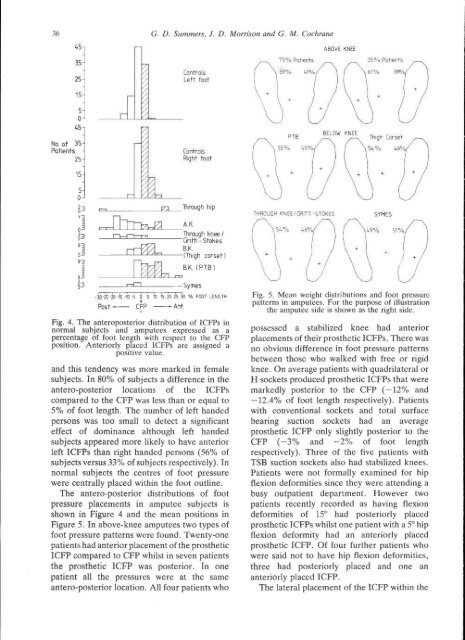View Complete Issue PDF
View Complete Issue PDF
View Complete Issue PDF
Create successful ePaper yourself
Turn your PDF publications into a flip-book with our unique Google optimized e-Paper software.
Fig. 5. Mean weight distributions and foot pressure<br />
patterns in amputees. For the purpose of illustration<br />
the amputee side is shown as the right side.<br />
Fig. 4. The anteroposterior distribution of ICFPs in<br />
normal subjects and amputees expressed as a<br />
percentage of foot length with respect to the CFP<br />
position. Anteriorly placed ICFPs are assigned a<br />
positive value.<br />
and this tendency was more marked in female<br />
subjects. In 80% of subjects a difference in the<br />
antero-posterior locations of the ICFPs<br />
compared to the CFP was less than or equal to<br />
5% of foot length. The number of left handed<br />
persons was too small to detect a significant<br />
effect of dominance although left handed<br />
subjects appeared more likely to have anterior<br />
left ICFPs than right handed persons (56% of<br />
subjects versus 33% of subjects respectively). In<br />
normal subjects the centres of foot pressure<br />
were centrally placed within the foot outline.<br />
The antero-posterior distributions of foot<br />
pressure placements in amputee subjects is<br />
shown in Figure 4 and the mean positions in<br />
Figure 5. In above-knee amputees two types of<br />
foot pressure patterns were found. Twenty-one<br />
patients had anterior placement of the prosthetic<br />
ICFP compared to CFP whilst in seven patients<br />
the prosthetic ICFP was posterior. In one<br />
patient all the pressures were at the same<br />
antero-posterior location. All four patients who<br />
possessed a stabilized knee had anterior<br />
placements of their prosthetic ICFPs. There was<br />
no obvious difference in foot pressure patterns<br />
between those who walked with free or rigid<br />
knee. On average patients with quadrilateral or<br />
H sockets produced prosthetic ICFPs that were<br />
markedly posterior to the CFP (—12% and<br />
-12.4% of foot length respectively). Patients<br />
with conventional sockets and total surface<br />
bearing suction sockets had an average<br />
prosthetic ICFP only slightly posterior to the<br />
CFP (-3% and -2% of foot length<br />
respectively). Three of the five patients with<br />
TSB suction sockets also had stabilized knees.<br />
Patients were not formally examined for hip<br />
flexion deformities since they were attending a<br />
busy outpatient department. However two<br />
patients recently recorded as having flexion<br />
deformities of 15° had posteriorly placed<br />
prosthetic ICFPs whilst one patient with a 5° hip<br />
flexion deformity had an anteriorly placed<br />
prosthetic ICFP. Of four further patients who<br />
were said not to have hip flexion deformities,<br />
three had posteriorly placed and one an<br />
anteriorly placed ICFP.<br />
The lateral placement of the ICFP within the
















